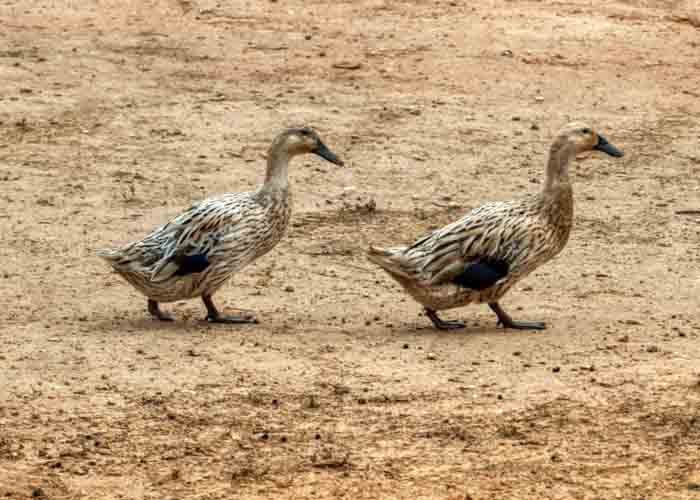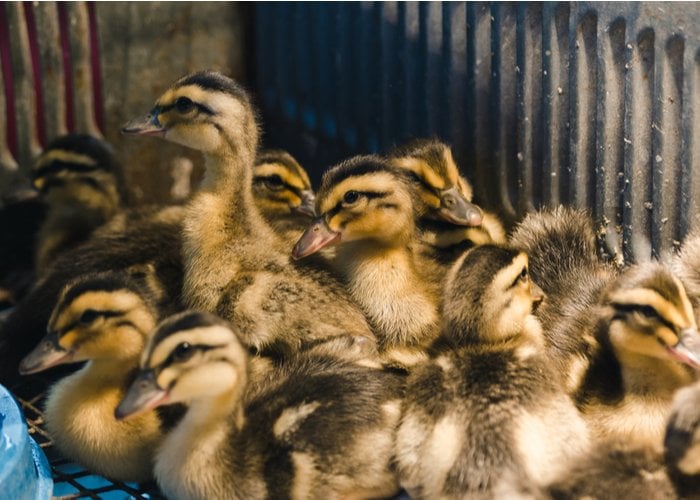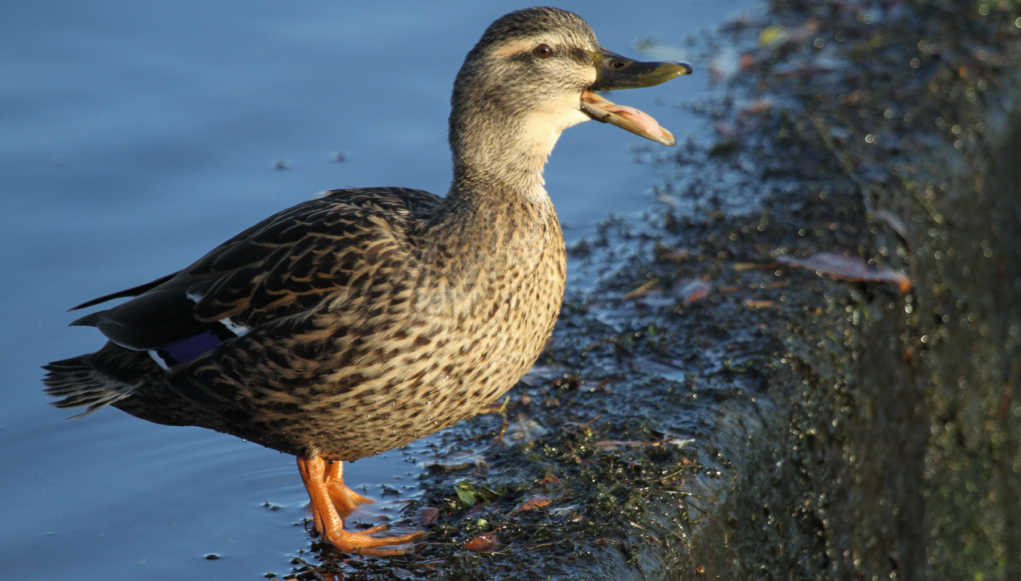Are you a newbie duck keeper looking for the best duck breeds for beginners to start your flock? You’ve come to the right place!
Ducks serve many purposes, including excellent backyard companions, but there is a wide variety of breeds to choose from.
Knowing which duck breeds are best suited for beginners can save you a lot of trouble, especially when you’re first getting started.
Read on to learn more about these beginner-friendly duck breeds.
Best Duck Breeds for Beginners
1. Buff
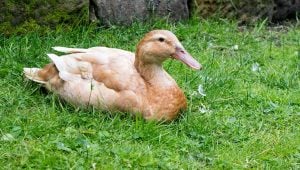
Buff Orpington ducks(sometimes simply called Buff Ducks) are excellent, all-around ducks that are suitable for all keepers and well-liked by most.
Background
William Cook was an esteemed poultry breeder from Orpington, Kent, who developed three varieties of the now-famous Orpington duck: Blue, Black, and Buff.
The unique buff color was conceived by cross-breeding Cayuga ducks with Runner Ducks, Aylesbury, and Rouen breeds to achieve this fashionably praised hue during England’s plumage trend in the early 1900s.
In 1908 William Cook introduced his beloved breed at theMadison Square Garden Showin New York City. There, it earned entry into the American Poultry Association’s ‘Standard Of Perfection’ under its distinct name, “Buff.”
Despite their impressive dual-purpose capacity, when industry growers followed consumer interest in cheap meat following World War II, the number of Buffs dwindled.
| Purpose | Multi-purpose for show, eggs, meat, and companionship |
| Noise Level | Medium |
| Hardiness | Cold-hardy |
| Personality | Friendly, likes people |
| Size | 7-8 pounds |
| Lifespan | 8 to 12 years |
| Free range | Excellent foragers and free rangers. Also does well in smaller spaces. |
| Eggs | 150 to 220 per year |
| Appearance | Rich brown with yellow to orange bills, feet, and shanks. The tails are curled, and their necks are long, curved, and graceful. |
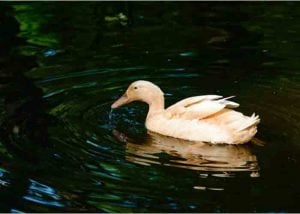 Characteristics
Characteristics
The Buff breed is a great option for the breeder looking to combine both form and function.
Not only are these birds aesthetically pleasing, but they can also produce around 150-220 large white or tinted eggs every year!
Additionally, their rapid weight gain makes them ready for market within 8-10 weeks of hatching.
Several ducks of this breed will feel compelled to hatch and raise ducklings of their own too. If you aren’t ready to invest in an incubator, this is a helpful attribute.
The Buff Duck gained recognition as an excellent meat bird that dresses out well due to its lack of light pin feathers on the plucked carcass.
Pekins are more common for meat production because they grow faster and are more economical, but Pekins are, objectively speaking, less flavorful than Buff Orpington ducks.
Why One of the Best Duck Breeds for Beginners
Buffs are well-suited for new duck keepers because they are versatile for most environments.
Whether you have sweltering summer, frigid winters (or both), Buffs will do well so long as they have a shady pool or pond in the summer and a draft-free building to weather the winter.
Of course, Buff ducks are excellent pets because they enjoy being around people and have pleasant personalities. They are beautiful birds too, which is just the cherry on top.
2. Call
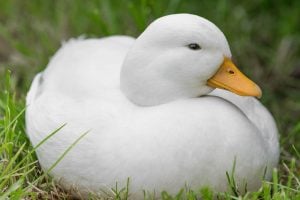
Call ducksare a small bantam breed with a big voice.
They are descendants of wild Mallards, originating in Asia, then later imported to the Netherlands.
Background
Call Ducks have a long and storied history that dates back to the 1800s in Great Britain, where they were used as “decoys” during hunting.
These ducks were the original “duck call,” calling out in their loud, high-pitched voices, and attracting wild ducks from miles around, luring them into the hunter’s traps.
They were wildly successful at luring in waterfowl. As you probably imagined, this practice has been banned almost all over because they made hunting too streamlined, leading to the overharvesting of wild ducks.
For the sake of ethics and conservation, call ducks are (mostly) no longer allowed as decoys or calls anymore.
| Purpose | Hunting (not anymore), companionship, show |
| Noise Level | Loud (obnoxious!) |
| Hardiness | Excellent cold-hardy, good for hot climates |
| Personality | Easy to tame, talkative, docile |
| Size | 15 to 20 ounces (around a pound) |
| Lifespan | 10 years |
| Free range | Love free-ranging, but must be “trained” to come home at night. |
| Eggs | 50 to 150 per year |
| Appearance | Short, round body with white feathers. A short neck, a round head, a short bill, and “button” eyes. |
Characteristics
Call Ducks are a true bantam duck breed; there isn’t a “standard” size version of this species.
They look little and snuggly too! Most are black or white, but you can get shaded variations of apricot, bibbed, blue-fawn, dark silver, magpie, pied, and silver.
Call ducks have yellow beaks, orange feet, a round head, a round body, and a short little neck.
This breed is very popular in children’s storybooks because of its precious appearance.
Their eggs are colorful, too. While most are white, a few females will produce sweet light shades of blue and green too.
You can free-range Call ducks, b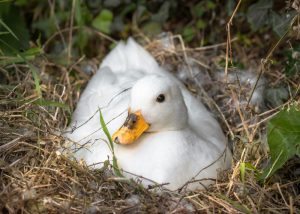 ut you should first establish a strong sense of their “home base” before turning them loose.
ut you should first establish a strong sense of their “home base” before turning them loose.
Unlike almost all other domestic duck breeds, call ducks are great flyers and can fly away if they are unhappy with their living conditions.
The best thing you can do to keep them home is to treat them well, keep a steady supply of feed, provide a swimming area, and give them a secure coop to sleep in at night.
他们也更容易被gro挑掉und predators and birds of prey due to their small sizes.
If you’re concerned about predators or the chance of them flying off, you may want to confine your call ducks to a secure coop and run.
And while Call Ducks are great for beginners, you should note that they are not suitable for quiet areas.
您是否想要保护你的沉默rm or you live in a subdivision, you should probably skip Call Ducks if lots of noise will be an issue for you (or your neighbors).
3. Khaki Campbell
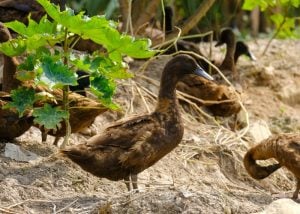
Khaki Campbellsare one of the most popular duck breeds in the United States, largely because they are so beginner-friendly and versatile as a whole.
Background
In the late 1800s, Mrs. Adele Campbell of Gloucestershire, England, was determined to find the perfect duck breed for her family.
她想要将大量的繁殖of eggs and have a good build for meat production.
Her innovative idea led to crossbreeding Indian Runner Ducks known for their egg-laying prowess with Rouen Duck’s larger body size.
They were excellent dual-purpose ducks, but the public wasn’t very interested in them—they were too dull in appearance.
They resembled plain Khaki-colored military uniforms. Mrs. Campbell then crossed her new Campbell Khakis with Pencil Runners to create a more colorful variety.
Thirty years later, thebreed was imported to the United States. Ten years after that, in 1941, they were accepted into the American Poultry Association’s Standard of Perfection.
| Purpose | 多用途为eggs, meat, and companionship |
| Noise Level | Mostly quiet; females are slightly noisier yet raspier than drakes |
| Hardiness | Hot and cold hardy |
| Personality | Independent, smart, and high-energy; Will befriend their keepers over time. |
| Size | 3.5 to 4.5 pounds |
| Lifespan | 10 to 15 years |
| Free range | Does not tolerate confinement well, excellent free-ranger |
| Eggs | 180 to 300 per year |
| Appearance | Khaki colored with a body similar to a Mallard. There are a few white tufts on the chest. Females are typically darker colored. They have black or green bills. |
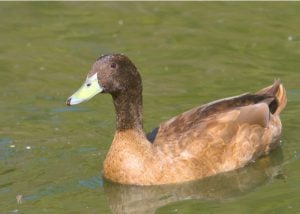 Characteristics
Characteristics
Khaki Campbells are sweet ducks that mostly prefer to be free-range and independent, but they are very capable of growing close to the people they interact with daily.
While it will take some patience and practice, they are suitable pets for calmer, quieter children.
It’s easy to mistake the captivating Khaki Campbell Duck for its wilder Mallard doppelgänger!
While they share many of the same traits, including boat-shaped bodies and long necks, there are some noteworthy differences.
The classic mottled khaki feathers distinguish them, with males possessing lightly colored features while females boast dark tones.
Their skin colors range from yellowish to white depending on what’s in their diet (this is mostly based on the protein content).
Khaki Campbells are not suitable for constant confinement—they strongly prefer free-range. They prefer ponds over pools but will settle for a pool if that’s all that is available to them.
They cannot fly, so they may be more prone to predator attacks.
A good way to compromise with Khaki Campbells is to keep them in their run until you’re able to supervise their free-range time.
Khaki Campbells are the perfect addition to a homestead, especially if you’re brand new to raising ducks.
Females will start laying eggs as early as 21 weeks and will lay 5-6 (sometimes 7) medium white eggs a week. They may lay eggs well into their ninth year of life as well.
4. Magpies

Magpiesare an underrated breed, especially for novice duck keepers. This cute black and white breed has a lot to offer and is versatile for many applications.
Background
Magpies are believed to originate in 1800s Wales after being developed by two men—M.C Gower-Williams and Oliver Drake.
They supposedly used Belgian Huttegem duck bloodlines as well as Indian Runner ancestry to create Magpie ducks.
It wasn’t until 1963 that Isaac Hunter was credited for introducing these birds into America, where it took another 15 years before they were officially recognized by the American Poultry Association under standard specifications of each variation: Black & White Magpies and Blue Magpies.
| Purpose | Dual-purpose |
| Noise Level | Quiet, with occasional chattering amongst each other |
| Hardiness | Heat and cold hardy |
| Personality | High-strung, friendly if frequently and consistently handled |
| Size | 3 to 5 pounds |
| Lifespan | 8 to 12 years |
| Free range | Prefers free-ranging over confinement, prefers ponds over pools |
| Eggs | 220 to 290 eggs a year |
| Appearance | Black and white plumage (or blue and white), with a “flat cap” marking on their head. Long bodies, broad heads, yellow bills, and bright orange feet. |
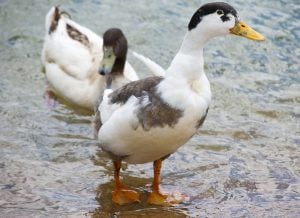 Characteristics
Characteristics
An interesting fact about Magpie ducks is that their eggs only need 18 or 19 days to hatch—nearly a week sooner than other duck breeds.
Magpies are less inclined to sit on a clutch of eggs than other breeds, but there are plenty of exceptions on an individual level.
Those who do hatch their eggs will typically “save up” six eggs before sitting on them.
Once her ducklings hatch, she is a fantastic, watchful mother who teaches them how to forage and fiercely protects them from predators.
If you plan on keeping a flock of Magpies, make sure you keep at least five females for every drake.
The drakes are aggressive with a high libido; it’s best to keep a larger ratio to keep the ladies safe and healthy.
Magpie eggs are green to blue in hue, with brown speckles and a creamy, robust flavor.
Another perk of raising Magpie ducks is their meat quality.
The carcasses are easy to clean, the meat has great flavor, and they have enough meat on their bones to make it worth your effort of harvesting and processing the birds.
Why Magpies is One of the Best Duck Breeds for Beginners
We recommend Magpies because they are gentle birds with great survival instincts.
They can tolerate most climates, and they are suitable for meat and egg production, which is a strong benefit for novices who may not be fully decided on which option they want to pursue.
They may be a bit more flighty than other birds on this list, but their intelligence and beauty typically outweigh their skittish behavior. Plus, you can gentle and befriend them with some time and patience.
Magpie ducks form strong bonds with their keepers, especially if their human is willing to spend much time outside and around their Magpie duck(s).
They are exceptionally docile and calm compared to some other breeds, such as Indian Runner Ducks; however, they can still be more skittish than Pekins, Rouens, and Khaki Campbells.
While these adorable birds may look like they could fly—it’s tough for them to get off the ground for more than a few strides.
They can hop and then fly a few feet upwards, but that’s the extent of their abilities.
If you let them free-range, they won’t be able to evade ground predators well.
You may need to watch them, keep them in a secure run, or provide them with a guardian animal for their protection.
Letting Magpie ducks free-range your property will significantly reduce your insect (including tick, flea, and mosquito) population, nice!
5. Pekin
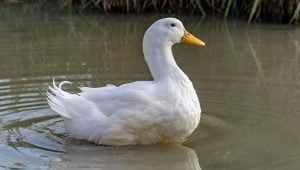
Pekin ducksare incredibly popular in the United States, and they have absolutely earned this popularity.
This multi-purpose breed is an affectionate, beautiful, intelligent, and strong producer of high-quality meat and eggs.
Background
With a known, written history of over two millennia, the Pekin duck is renowned as one of the oldest domesticated breeds.
Despite ongoing debate among experts about its origin story, most agree that this popular bird was likely first bred in Southeast Asia before being introduced to England and later America around 1872.
Its popularity reigned supreme during these early years leading it to become the go-to choice for farmers across several continents.
| Purpose | 多用途为eggs, meat, and companionship |
| Noise Level | Medium |
| Hardiness | Cold hardy |
| Personality | Friendly, likes people |
| Size | 8-9 pounds |
| Lifespan | 8 to 12 years |
| Free range | Excellent foragers and free-rangers |
| Eggs | 200 to 300 per year |
| Appearance | Creamy white, orange shanks and toes, yellow bill, broad neck atop a long, broad, deep body. |
 Characteristics
Characteristics
Pekin ducks are instantly recognizable.
They are bright yellow as ducklings, and white feathers slowly emerge as they mature.
All Pekins have distinctive deep orange shanks and bills—a glossy shade of old gold that can be speckled for an added character on some older adults.
Pekins produce large quantities of meat; if you’re interested in raising ducks for this aspect, Pekins should be a strong contender for you.
They are mature at six weeks old and will weigh approximately six pounds.
Jumbo Pekin ducks are ready at twelve weeks and will weigh nine to eleven pounds at this point.
Why Pekin Ducks is One of the Best Duck Breeds for Beginners
A strong reason why we recommend Pekins for newbie duck keepers is their gentle disposition—it is unlikely that you’ll be attacked or challenged by a Pekin duck.
Still, becoming their friend takes some amount of effort on your part.
You need to raise them as ducklings or spend a lot of quality time with them outside. Treats are always helpful too.
With time, your white-feathered friends may run to greet you and ask for your attention.
6. Welsh Harlequins
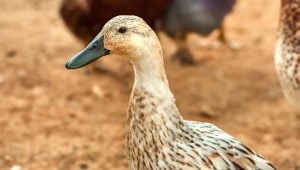
Welsh Harlequinsare excellent farm birds as they are relatively hardy when kept in a well-maintained environment with plenty of fresh water and food available, making them easy to care for and an increasingly popular option amongst newer poultry keepers.
| Purpose | Eggs and companionship |
| Noise Level | Mostly quiet |
| Hardiness | Hot and cold weather hardy |
| Personality | Amicable, docile, and active |
| Size | 5 to 5.5 pounds |
| Lifespan | 12 years (up to 20) |
| Free range | They can stay in a duck run but prefer to free-range, even if only for a few hours in the evening |
| Eggs | 250 to 300 eggs per year |
| Appearance | Reddish-brown color on the body, with brown and cream tail feathers. The body is streamlined but with a rounded chest, wide-set legs, and oval heads. |
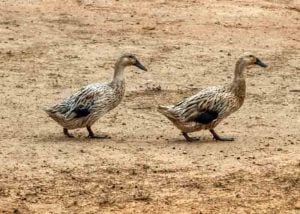 Characteristics
Characteristics
Welsh Harlequin Ducks are an incredibly unique breed of domesticated duck.
Not only do they stand out among other ducks thanks to their vibrant, multi-colored feathers, but they are also renowned for possessing the superb egg-laying ability and producing a high yield of large white eggs per season.
They were specifically bred and designed to lay lots of high-quality eggs all year long.
Despite their small stature, these ducks have a hearty appetite and will not hesitate to take on larger prey, such as smaller fish or frogs, when the opportunity arises, so it is important to monitor them closely if you decide to keep them around ponds or lakes.
We don’t recommend Welsh Harlequins if you have outdoor pet fish of any kind, especially goldfish, and koi.
On the bright side, they are fully capable of supplying most, if not all, of their diet through foraging your property.
Welsh Harlequins aren’t interested in challenging or attacking humans, but the drakes are aggressive with the female ducks, especially when there’s male competition.
Make sure you keep at least five (preferably seven or more) female ducks for every male duck in your flock. Too many males can stress and even kill your females.
Why Welsh Harlequin is One of the Best Duck Breeds for Beginners
Welsh Harlequin Ducks are an ideal choice for farmers and hobbyists just starting out with raising ducks.
They require very little effort to keep; they are versatile, hardy birds who are able to adapt to nearly any climate and terrain.
They can easily fit into a backyard or farming operation of any size, making them ideal for those with limited (and seemingly unlimited) spaces.
These ducks mature quickly and begin laying many delicious eggs early in life, which helps beginners reap the rewards of raising ducks faster than other breeds.
Lastly, their bright plumage looks fantastic both in natural settings and when used in shows.
If you’re looking for a backyard friend who will be with you for a long time, Welsh Harlequins are a great option.
The oldest recorded duck of this breed lived to be more thantwenty years old.
The Best Duck Breeds for Beginners: Final Thoughts
If you’re a newbie looking for the best duck breeds for beginners, there are many wonderful ones to choose from.
Buff Ducks, Call Ducks, Khaki Campbells, Magpie Ducks, Pekin Ducks, and Welsh Harlequin Ducks each have their own unique characteristics that make them great options for someone just starting out with ducks.
They are adaptable in a variety of climates, kind to humans, and many lay lots of eggs while making great family pets.
Taking the time to find the right breed of duck can pay off big in terms of having healthy and happy birds!
With a little patience and dedication, you will find yourself enjoying your newest feathered friends for years to come!
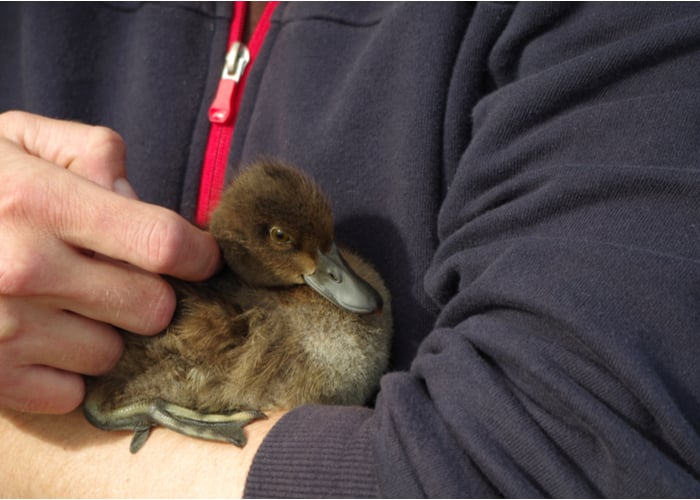
 Characteristics
Characteristics Characteristics
Characteristics Characteristics
Characteristics Characteristics
Characteristics Characteristics
Characteristics